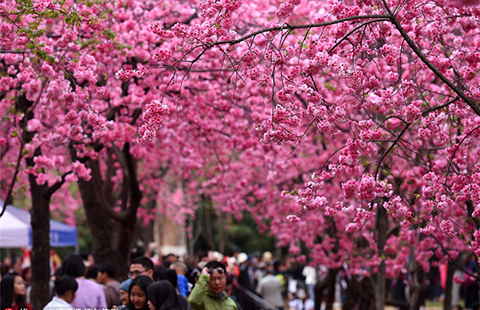Nanorobot may aid fight against cancer
Updated: 2016-10-25 07:42
By Dara Wang in Hong Kong(China Daily)
|
||||||||
Research team develops tiny device to target specific cells in the body
A research team from the University of Hong Kong has developed the world's first light-guided nanorobot, a submicroscopic device with the potential to travel through the bloodstream, curing sickness.
Some experts say nanorobots as key components in scientific efforts to heal medical conditions.
The device's developers say it has the potential to help remove tumors and block the growth of cancer cells. The tiny robot was developed over three years by an eight-member team led by assistant professor Tang Jinyao from the chemistry department of the university.
The device compares in size to a human blood cell, with a diameter of only 2 to 3 micrometers. Injected into the human body, it can travel through the bloodstream, with wide applications for biomedicine.

Guided by light as dim as a table lamp, the nanorobot can move in different directions. "The early model could be capable of delivering medications into cancer cells to block their growth without harming nearby cells," Tang said.
The findings were published on Oct 17 in the scientific journal Nature Nanotechnology.
Previously, the only method to remotely control nanorobots was by incorporating a tiny magnetic field inside the motor. However, the single transmitting direction of magnetism limits the variety of information it can carry.
One of the breakthroughs by Tang's team was to direct more precise orders to the device through light, because light has more variances in color, direction and focal points than a magnetic field.
The inspiration comes from the movement of green algae, a single-celled organism that can sense the direction and intensity of light and swim toward the source.
Based on this concept, the team developed the nanosized robot using two easily obtained semiconductor materials-titanium dioxide and silicon-both of which have high light sensitivity.
Both materials are nontoxic and can be broken down, enhancing their biocompatibility, Tang said.
In its current stage, the tiny robot is guided by ultraviolet light, which is easily sensed, but causes radiation, Tang said. The team is exploring the possibility of the robot being driven by infrared rays that emit lower energy and thus cause less damage.
Functioning like a solar battery, the motor requires an aquatic solution to produce a chemical reaction. The team is looking for possible chemical elements to simulate the blood components to enhance the motor's compatibility in the human body, said Dai Baohu, a PhD student from the team.
dara@chinadailyhk.com
(China Daily 10/25/2016 page5)
- Lavrov, Kerry discuss Syrian situation
- Turkish troops kill 17 IS militants since Mosul operation: FM
- 59 killed in attack on police academy in Pakistan
- Syrian forces capture new area in Aleppo
- Fate of child migrants uncertain before France demolishes Jungle camp
- Former Japan SDF official believed to have blown himself up, injures 3

 Top 5 property destinations for Chinese investors
Top 5 property destinations for Chinese investors
 Accompanying satellite sends back images of Tiangong II, Shenzhou XI
Accompanying satellite sends back images of Tiangong II, Shenzhou XI
 Dare you jump
Dare you jump
 Through the lens: Under the blue sky of Tibet
Through the lens: Under the blue sky of Tibet
 Military blind date attracts hundreds young women
Military blind date attracts hundreds young women
 Britain's Red Arrows arrive at Zhuhai for China air show
Britain's Red Arrows arrive at Zhuhai for China air show
 Villagers build ladder on cliff with 1,500 steel pipes
Villagers build ladder on cliff with 1,500 steel pipes
 Colorful leaves adorn Great Wall in Beijing
Colorful leaves adorn Great Wall in Beijing
Most Viewed
Editor's Picks

|

|

|

|

|

|
Today's Top News
'Zero Hunger Run' held in Rome
Trump outlines anti-terror plan, proposing extreme vetting for immigrants
Phelps puts spotlight on cupping
US launches airstrikes against IS targets in Libya's Sirte
Ministry slams US-Korean THAAD deployment
Two police officers shot at protest in Dallas
Abe's blame game reveals his policies failing to get results
Ending wildlife trafficking must be policy priority in Asia
US Weekly

|

|







